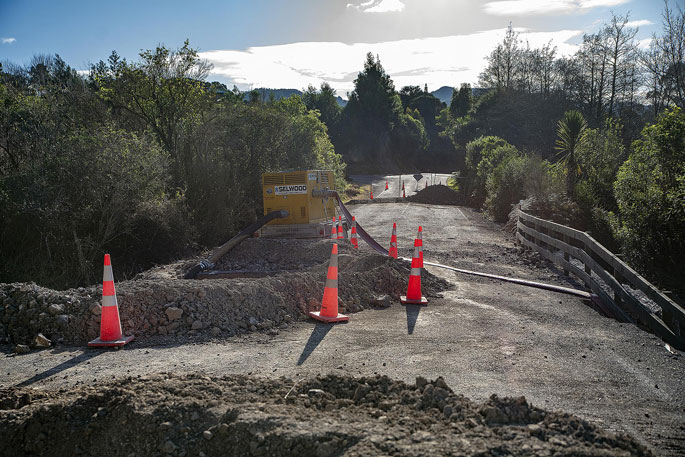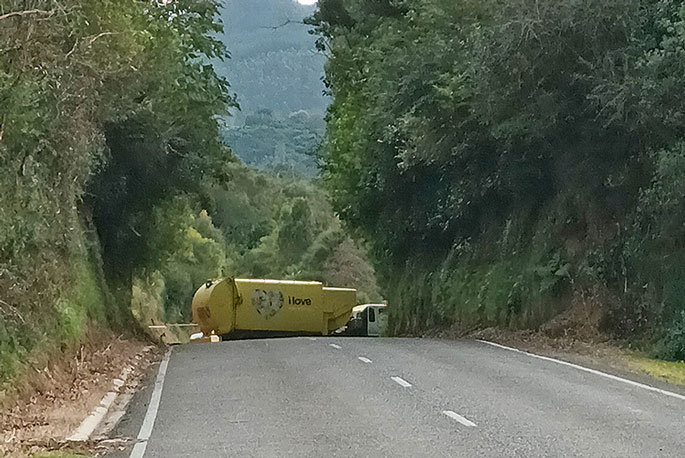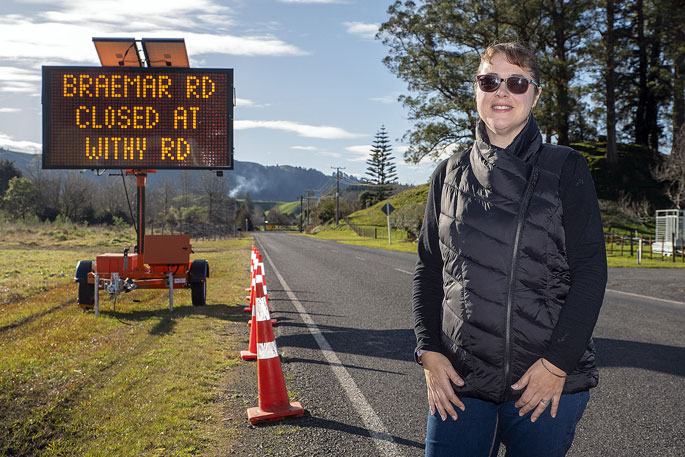Braemar Road residents are dismayed to hear the road is expected to remain closed for the “foreseeable future”.
Whakatāne District Council closed the road early this month after a blocked culvert, 100 metres past Withy Road on the Onepū side, resulted in part of the road collapsing.
Braemar Road dairy farmer Asheley Herring says the road closure has added an extra 20 kilometres to a trip into town.
Living just metres from the Onepū side of the closure, rather than travelling to Whakatāne via Caverhill Road and State Highway 2, she now needs to travel almost to Rotomā and via SH30.
Asheley understands it's not an overnight fix but hopes the council will make it a priority.
“I’m not whinging. Yet.”
She says the road being closed is an inconvenience to residents, but it's causing the most problems for the services residents and farmers relied on.
“For the first week, New Zealand Post refused to deliver mail to the area.
“We weren’t even told about it, we just stopped getting our mail. When we rang to find out what was going on we were told we had to come into Whakatāne to collect our mail.”
She says they has since negotiated to have two deliveries a week from New Zealand Post.
She has also had issues with having gas cylinders changed, with service people saying they would not do it until the road was fixed.
“I said, ‘we can’t wait until then. You are just going to have to go around the other way’.”
 A pump carrying water across the blocked culvert is the only work currently taking place.
A pump carrying water across the blocked culvert is the only work currently taking place.
The extra distance also causes inconvenience and extra fuel costs to milk tankers, feed suppliers, fuel tankers and other farm suppliers.
In a letter to residents on July 7, the council said it hoped the work could be completed without the need for a prolonged road closure, however, a second letter on July 18, explained the repair required was extensive and the road would remain closed “for the foreseeable future while investigation and design work is carried out”.
Whakatāne District Council strategy and asset management team leader Ann-Elise Reynolds says the damage to the culvert followed an unprecedented amount of rainfall in the past 12 months.
 A large cavity under the culvert near Withy Road is the reason for the road closure. Photo supplied.
A large cavity under the culvert near Withy Road is the reason for the road closure. Photo supplied.
After three days of unsuccessful attempts to unblock the culvert, a large tomo, or sinkhole, opened up on the northbound lane exposing a cavity the full width of the lane.
Tension cracks are visible on the southbound lane and part of the retaining wall has collapsed.
A large quantity of water has built up behind the culvert and a pump is currently operating at the site to remove this until the blocked culvert is repaired or replaced. This is the only visible work happening at the site.
The complexity of the repair required work to be done in preparation before any further physical repair works could occur, says Ann-Elise.
“We're doing all we can to establish expected timeframes and will let you know as soon as we have this information.”
In spite of a large sign near the intersection with State Highway 30 declaring the road is closed at Withy Road, Asheley says a lot of traffic is still trying to use the route between Onepū and Matatā.
With only a small turning area at the road barrier, it means a difficult manoeuvre for large vehicles when they realised they could go no further.
 A rubbish truck turns around at the barrier blocking off the impassible culvert. Photo supplied.
A rubbish truck turns around at the barrier blocking off the impassible culvert. Photo supplied.
“Last weekend I saw someone towing a boat having to turn around down there. I guess they were coming from Lake Rotomā, headed to Matatā. We thought, ‘they’re going to have trouble when they realise they have to turn around’. Sure enough, a while later they came back past our house.”
Even the council’s rubbish contractors apparently haven’t received the memo.
Asheley shared a photograph taken on Monday of a rubbish truck turning around at the barrier. She thinks it was the truck that emptied the council’s rubbish bins at Braemar Spring.
Ann-Elise says the impacts of climate change and the extremely heavy rain across the district in the past 18 months has caused widespread damage to the council’s roading networks.
“In particular, communities within the Herepuru, Stanley, Manawahe and now Braemar areas have been particularly affected,” she says. “We’re seeing escalating costs and challenges responding to weather damage to our roads and this isn’t just a local issue – it’s been seen right across the country.
“We empathise with affected residents and would like to reassure them we’re doing all we can to undertake works as quickly as possible while ensuring the safety of all road users and contractors, and while managing working within the parameters of material supply, ordering and delivery timeframes.”
Public Interest Journalism funded through NZ On Air.




0 comments
Leave a Comment
You must be logged in to make a comment.